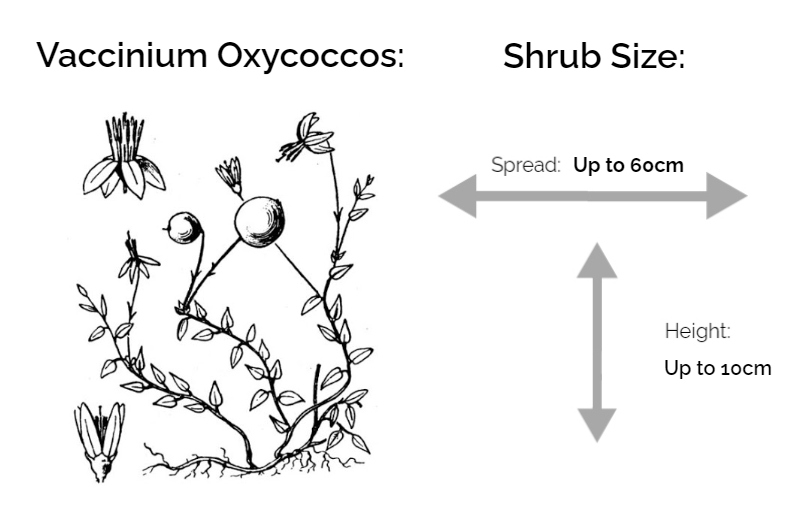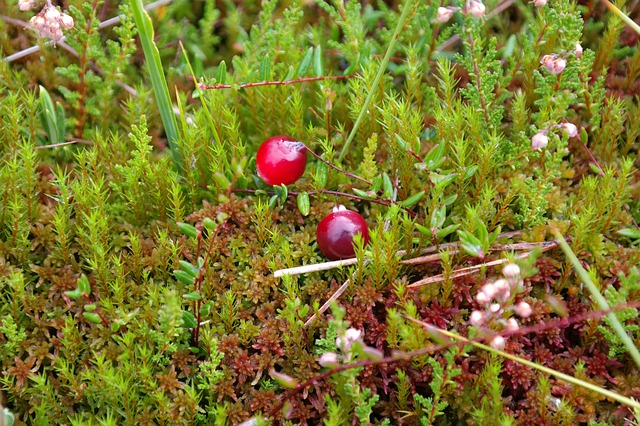Wild Cranberry (Vaccinium oxycoccos) is one of those plants you don’t even know exist, but when you find out about it, you just can’t get enough. The juicy fruits just pop into your mouth and release a delicious sweet and sour flavor you just won’t forget.
You can make jams with it, or even some hearty wild rice cranberry bread that everyone will go crazy over.
As a tree planter working in the forest, I’ve had the chance to see them in the wild many times. In some places that I plant, they’re literally everywhere! It’s hard not to stop and take a few for myself!
It grows on small vines that are very hard to notice. They’re pretty similar looking to creeping snowberry, so it’s easy to mix the two when they’re not fruiting. When I forage for this herb, I really try to pick sustainably, and I think everyone should too.
If you go out ripping out all the wild cranberry fruits in plants near you, the populations might just not recover at all.
Today I’d like to share with you my knowledge of this wonderful wild fruit.
Here’s what you can expect to learn in this article:
- Picking Season
- How to Identify Wild Cranberry
- Where You Can Find it
- How to Harvest it Sustainably
- How to Propagate Wild Cranberry
- How to Store it
- Wild Cranberry use in Forestry
Let’s get started!
Wild Cranberry Picking Season

Wild cranberry is an evergreen plant, which means it won’t lose its leaves during winter. This means the leaves can be picked any time of the year but it’s the fruit we’re after.
From my experience, when wild cranberries start to fruit, they take quite some time to mature into the bright red cranberry we know.
At first, they’ll be a light green color and will be very tart. It’s only at the end of summer that they fully ripen and are ready for picking.
The best time of the year to pick wild cranberry is from August to October.
How to Identify Wild Cranberry (Vaccinium oxycoccos)

Wild Cranberry (Vaccinium oxycocos) is a low-lying vine-like plant with small lance-shaped (lanceolate) leaves, with curled-under, entire margins that grow in an alternate arrangement on the stem.
Its leaves are dark green, and its thin stems are burgundy red but the leaves can turn into a reddish-brown color under certain conditions.
Wild cranberry plants produce fruits but the quantity depends on the location. The fruits look like little green spheres and turn red later in the season.
When they bloom from May to July, they make beautiful pink flowers.
Where You Can Find Wild Cranberry
You can find wild cranberry growing in peat bogs where moss is present. It often grows in abundance on mossy forest floors and near dead tree stumps. It’s a companion plant to creeping snowberry.
Common habitats for wild cranberry are freshwater lake edges where the soil is humid all year long.
They are found in the large part of the Canadian boreal forest and as south as West Virginia.
I’ve seen Wild Cranberry grow near the following plants:
- Creeping Snowberry (Gaultheria hispidula)
- Labrador Tea (Rhododendron groenlandicum)
- Black Spruce (Picea mariana) & White Spruce (Picea glauca)
- Rusty Brown Sphagnum (Sphagnum muscum)
When you see any of these, you might find wild cranberry somewhere close, it’s always good to keep that in mind.
How to Harvest Wild Cranberry Sustainably
Since this plant doesn’t grow very fast, you want to be very thoughtful of each vine when you pick.
My personal method for picking them sustainably:
- Find a sphagnum moss mound with cranberry growing on it.
- Pick some of the fruits off, but leave a few on them.
- Move on to the next plant.
It’s simple, leaving some fruits on there will give the plant a chance to spread its seeds naturally.
Something else I like to do when I see the red fruits is to toss some on the ground and cover them with a bit of forest litter.
You don’t need to bury them, they need to go through natural stratification. The best way to help them is to cover them with leaf litter, then they’ll have a better chance to germinate next spring.
How to Propagate Wild Cranberry (Vaccinium oxycoccos)

Hardiness Zone: 2-7

Soil Type: Well-drained, acidic soil rich in peat.

Water: Wet. Regular moisture is important.

Exposure: Full sun to Partial Shade
Wild Cranberry (Vaccinium oxycoccos) is an evergreen, berry-producing shrub hardy up to zone 2. Its vine should be planted in a well-drained, acidic, peat-rich soil. You should water it weekly to make sure it retains moisture.
Commercial Value
Propagating wild cranberry has some merit commercially. The fruits are delicious and they have medicinal properties that make them popular.
The fruit is rich in antioxidants. It can be used to treat disorders of the kidney and bladder.
Cranberry juice is used as a preventative measure to stop bacteria from sticking to the walls of the bladder. Being rich in iron and vitamins, cranberry is also useful to stop the formation of dental plaque.
Growing and propagating them can become profitable if done right.
The Best Way to Propagate Wild Cranberry:
Division
Cranberry can be propagated easily by division. This is because they naturally spread by stolon (horizontal stems).
Here’s how to do it:
- Find a wild cranberry patch and identify the largest plant.
- Follow some vines from a mother plant, there should be plenty.
- Pull up slightly on a vine and you’ll see some parts are attached to moss by root.
- Carefully pull the roots out and snip the part of the vine you want.
- Keep moist until you transplant, and that’s it!
If you want to grow them on a large scale, having many mother plants to divide from is the way to do it.
The fruits also have seeds in them, if you harvest the seeds properly, you can also grow from seed.
How to Store Freshly Picked Wild Cranberry
If you don’t plan on eating the cranberries right away, you should probably dehydrate them.
The best way to do this is with a small fruit dehydrator, they can go for roughly $100 online.
First, you want to clean them with running water. Just clean them in the sink and pat them dry, then place them into your dehydrator.
Dehydrating wild cranberries take up to 14 hours, after that, they’ll be so much easier to preserve!
Finally, place them in a sealed mason jar, stored away in a cool dark place.
When you feel like some cranberries, just pop out the jar! They’re great to add into trail mixes or they make awesome wild rice cranberry bread. You’ll get to smell and taste the delightful aroma again!
Wild Cranberry Application in Forestry
I really think conserving the growth of this plant in our forests is important. There’s a potential to develop our forestry industry further with plants like these.
The lumber industry could be much less wasteful and use Non-timber forest products that go to waste in logged areas.
We can harvest plants like wild cranberry and also reseed them.
Let me give you an example, tree planters go and reforest areas cut clear for lumber, and add new seedlings to populate the area. Why couldn’t we also seed plants like wild cranberry to add more value to these tree plantations?
Maximizing the use of tree plantations deserves merit, doesn’t it?
- We start by respecting the biome
- Only plant what already naturally grows there
- Harvest NTFP (non-timber forest products) along with lumber
- Bring in more jobs from the harvest and the value addition after (transforming into dried fruit, or packaging for fresh sale, etc.)
Food for thought?
Let me know what you think!




